The 2025 EOS and OKRs Guide: What are EOS and how are they different from OKRs?
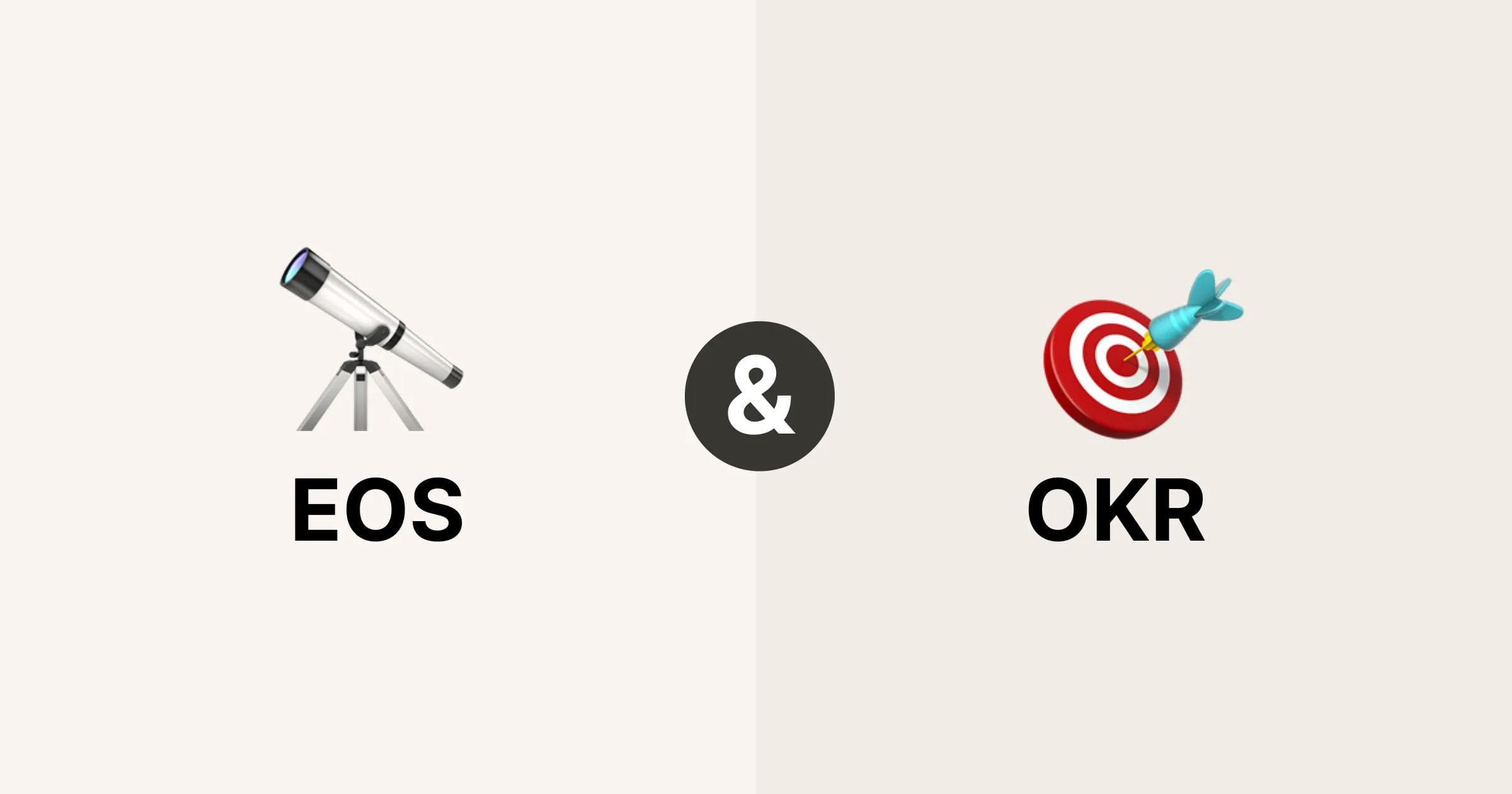
Organizational management and goal-setting can often be complex and challenging, both for emerging and established companies. Enter EOS (Entrepreneurial Operating System) and OKRs (Objectives and Key Results), two prominent frameworks designed to drive companies toward efficiency, alignment, and growth.
Understanding how these two frameworks work both separately and in combination can help businesses achieve new levels of success. What exactly EOS and OKR are, how the frameworks differ, and how they can be used together will be explained in this article.
What to expect:
- What are EOS and OKRs?
- EOS vs OKRs
- Combining EOS and OKRs
- Conclusion
Understanding EOS and OKRs
What is EOS?
Starting a business isn't easy, and growing it can be even tougher. Gino Wickman, the creator of the framework, faced these challenges himself when he took over his family business at the age of 25. He developed a simple solution to overcome these challenges: the Entrepreneurial Operating System (EOS).
The EOS is not a computer operating system, but rather a people operating system that revolves around a three-year picture and consists of concepts and tools meant to simplify management processes – it aims at uniting teams, simplifying communication, and clarifying the company’s vision.
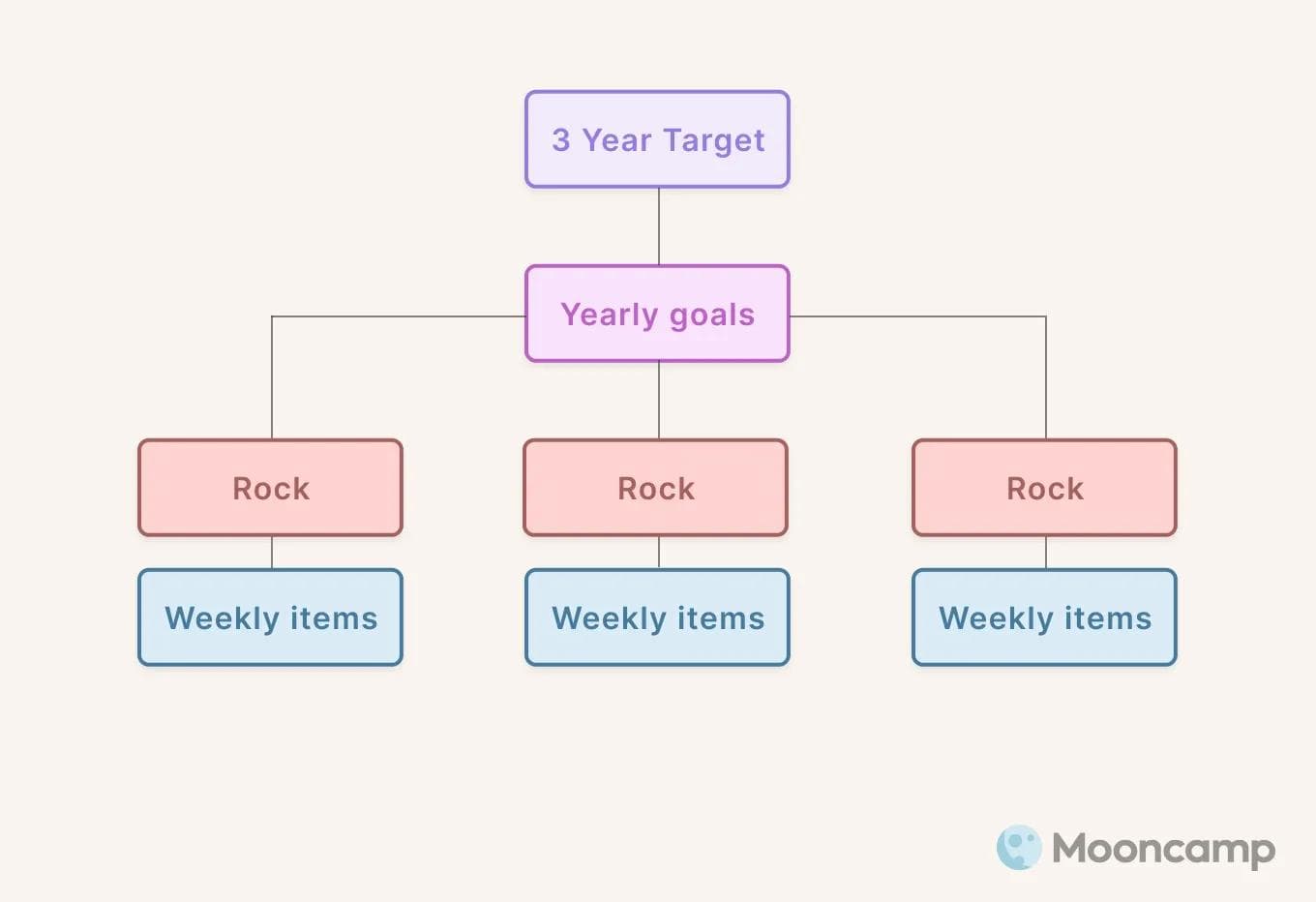
The EOS comprises three elements:
- Year-long goals: Overarching objectives that a company aims to achieve within 12 months.
- Rocks: Quarterly priorities that represent a team’s 3-7 most important goals. They help break down the year-long goals into actionable steps.
- Weekly to-do items: Weekly tasks that need to be accomplished in the short term. They serve as the tactical actions required to advance the Rocks and ultimately the year-long goals.
The KPIs and overall progress are tracked with the help of an EOS scorecard, and then the progress of the individual goals and tasks are discussed and updated in weekly meetings – Level 10 Meetings – held by the executives. These regular meetings help streamline tasks by creating a systematized process: teams follow the set steps for repetitive tasks, saving time and energy, and allowing for more focus on innovation and growth.
Additionally, the EOS is built around six components.
- Vision: Having a vision is an important part of the EOS method, as it gets everyone on the same page and ensures focus. Without a vision, a plan cannot be made – the vision serves as the guidance and drive of the company.
- People: To achieve the desired vision one needs the right people, not only at the executive level but also in the different teams. Hiring people who understand and support the company’s vision is crucial for the realization of the goals.
- Data: Basing decisions on data can prevent mistakes and accelerate effective decision-making. This is why setting measurable objectives and tracking metrics is important when using the EOS process.
- Issues: No company is problem-free – identifying, solving, and reflecting upon issues is an essential part of the EOS method. By creating a list of issues and determining methods to overcome them, companies enable internal growth and development.
- Process: This component is about systemization. It’s about creating consistency when executing core business processes, ensuring that the business can scale and grow without hiccups.
- Traction: With the vision, people, data, issues, and processes aligned, the traction component is about execution – making the vision a reality. It involves discipline, communicating, breaking down the goals, accountability, and achieving every part of the company's vision.
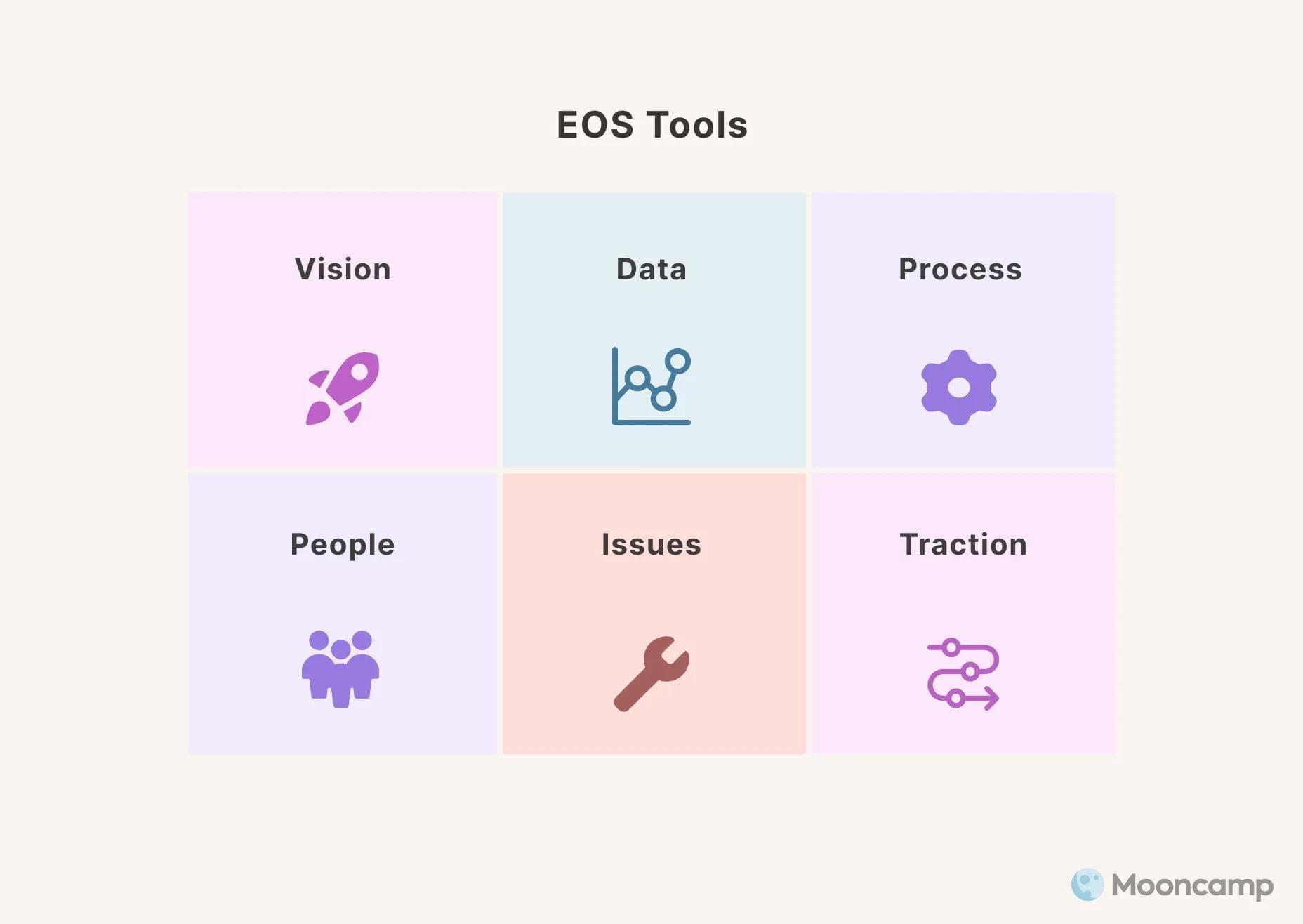
So now you know about EOS, but what are OKRs?
What is OKR?
OKR (short for "Objectives and Key Results") is an agile framework for formulating and implementing strategic goals in companies that consists of three core elements:
- Objectives: What do I want to achieve?
- Key Results: How do I know that the goal has been achieved?
- Initiatives: How do I achieve the objective?
As a rule, 2 to 4 Objectives are formulated per team and 2 to 4 result-oriented Key Results per Objective. The output is then mapped in initiatives (= concrete activities). More basic knowledge can be found in our OKR guide.
The primary goal of OKRs is to align individual, team, and organizational efforts around clear and measurable outcomes. By focusing on specific Objectives, OKRs ensure that everyone in the organization understands the strategic goals and how they fit into the larger vision, promoting alignment and transparency. They also help teams and individuals focus and prioritize activities that drive progress. Lastly, by regularly reviewing OKRs through weekly check-ins, teams and individuals are held accountable for their progress and results, creating a culture of accountability.
💡 Tip: If you want to get a closer look at the benefits of the framework, you can find an overview of all OKR-benefits on our blog.
Now that we've unpacked OKRs, let's explore how they intertwine with EOS.
EOS vs OKRs
Both EOS and OKRs are methodologies designed to help organizations achieve their goals. Thus, it is only logical that they bear some resemblances.
Key similarities between EOS and OKRs
- Alignment: Both methodologies aim to align teams and individuals with the organization's strategic goals. This ensures everyone is moving in the same direction.
- Accountability: OKRs and EOS equally stress the importance of individual and team accountability. They ensure that roles and responsibilities are clearly defined, and progress towards goals is tracked.
- Regular check-ins: The importance of progress reviews through regular meetings is prevalent in both approaches. OKRs often involve frequent check-ins, while EOS has structured Level 10 Meetings.
- Focus on prioritization: Both help the organizations concentrate on the most critical goals. EOS does this through its concept of "Rocks," while OKRs achieve this by setting measurable Key Results that are directly aligned with overarching Objectives, ensuring focus on priority areas.
Key differences between EOS and OKRs
Although they have many similarities, it's also crucial to recognize their unique differences. After all, knowing these distinctions can help decide which is better for your organization or how you can combine the two approaches effectively.
Purpose and origin
- EOS: Designed to provide a comprehensive management system that helps businesses harmonize all aspects of their operations. It's rooted in the book "Traction" by Gino Wickman and emphasizes six key components: vision, data, process, traction, issues, and people.
- OKR: A goal-setting framework that helps organizations define and track objectives and their outcomes. Originated at Intel and popularized by John Doerr, a renowned venture capitalist known for his early investment in Google, OKRs focus on setting ambitious goals with measurable results.
Structure
- EOS: Involves a set of tools and processes that integrate into the daily rhythm of a business. EOS uses a 90-Day World™ where goals and initiatives are set for each quarter.
- OKR: Comprises Objectives, which are qualitative and inspirational goals, and 2-4 Key Results, which are specific measures used to track the achievement of that goal. OKRs are typically set quarterly but can also be set on any other preferred schedule such as on an annual or trimester basis..
Flexibility
- EOS: More prescriptive in its approach, with a defined set of tools and processes that companies are encouraged to follow closely to get the best results.
- OKR: More adaptable and can be customized to the needs of the organization. It allows for more freedom in how Objectives and Key Results are defined and measured.
Scope and scale
- EOS: Best suited for small to medium-sized businesses looking for a holistic system to manage their entire operation.
- OKR: Can be used by organizations of all sizes, from startups to large enterprises, and is especially popular in the tech industry.
Implementation
- EOS: Typically requires a facilitator, often an EOS Implementer™, to teach the system, help set it up, and guide the leadership team through the process.
- OKR: Can be implemented internally with resources such as books or workshops, and it's common for companies to appoint an OKR champion to lead the process.
Tracking and accountability
- EOS: Uses weekly meetings called Level 10 Meetings™ and quarterly pulsing to ensure accountability and keep teams on track with their goals.
- OKR: Relies on regular check-ins, often weekly, to update on Key Result progress and to adapt or revise Objectives as needed.
Cultural impact
- EOS: Focuses on strengthening the company culture by building a healthy, functional, and cohesive leadership team.
- OKR: Encourages a culture of innovation, risk-taking, and continuous improvement through ambitious goal setting.

As shown, the methodologies have some differences. So when should one opt for EOS or OKRs?
EOS or OKR?
The EOS provides a structured, bottom-down approach that helps entrepreneurial businesses reach their goals. It offers crucial guidance, especially for smaller organizations. New companies or organizations that prefer structure might therefore opt for EOS.
However, as a company expands – introducing new departments and numerous employees – the rigidity of EOS may pose challenges. Leaders may struggle to maintain clear oversight, risking misalignment in departmental objectives and potential missteps in goal-setting. Additionally, employees may become disconnected from strategic goals, causing demotivation and deviations in task execution.
In contrast, OKRs can be used in companies of all sizes and are ideal for fast-paced and innovative industries since the framework can be adapted to a company’s changing needs. The framework however offers fewer tools and has less structure than the EOS which is why less experienced companies might struggle with this approach.
The good news is that you don’t have to pick one. Instead, you can use both approaches simultaneously to maximize their effect.
The power of combining EOS and OKRs
Merging OKRs with EOS enhances the unique advantages of each system and addresses potential gaps. It helps new businesses grow with the structure of EOS and, as they get bigger, they can use the flexible OKR method. Together, they offer a clear way to set and reach goals at all stages of the company’s development.
Complementary nature
The flexible nature of OKRs allows for a seamless integration of the framework. For example, the EOS Rocks – quarterly goals – can be reshaped into Objectives and combined with measurable Key Results. The measurability of Key Results streamlines the process of scoring and reviewing goals and helps pinpoint and solve problems.
Integrating OKRs in the EOS, therefore, enables a balance between a structured, comprehensive approach with clear roles, responsibilities, and processes (EOS) and an agile framework that can be adjusted to changes within the company and makes goal-tracking easy (OKRs). In sum, the combination of structure and agility can cater to long-term vision and short-term actionable goals.
Transparency
As a holistic system, the EOS focuses on creating a vision for the organization's long-term future. It defines the long-term vision and breaks it down into actionable steps (Rocks) via a top-down approach. Unfortunately, this top-down approach can also obscure the overall transparency in larger organizations as it disconnects departments and employees from company-wide goals. OKRs can help tackle this.
By formulating EOS Rocks as Objectives and pairing them with 2-4 measurable Key Results, companies can tie the strategy to team goals and connect everyday tasks to strategic objectives. It also keeps things flexible and ensures that everyone is involved in the goal-setting process. Simply put, using EOS with OKRs helps everyone see the long-term goal and understand how to reach it.
Boost accountability and engagement
While EOS uses detailed meetings at the executive level to assess progress and increase organizational alignment, the Key Results and quick OKR check-ins offer current insights and keep everyone in the loop – creating alignments among teams and individuals. This strengthens accountability and encourages cross-departmental collaboration.
OKRs also promote a sense of ownership since teams and individuals set their Objectives and align them with the company's goals. When paired with the strict structure and processes of EOS, this can boost motivation and engagement, since everyone knows their part in the larger organizational journey and how to achieve it.
Feedback and iteration
OKRs emphasize frequent feedback and iteration through their check-ins, allowing for real-time adjustments while the structured meetings of the EOS framework ensure consistent reflection on the organization's direction. When combined, they create a continuous feedback loop, ensuring the organization is always moving in the right direction and making necessary course corrections promptly.
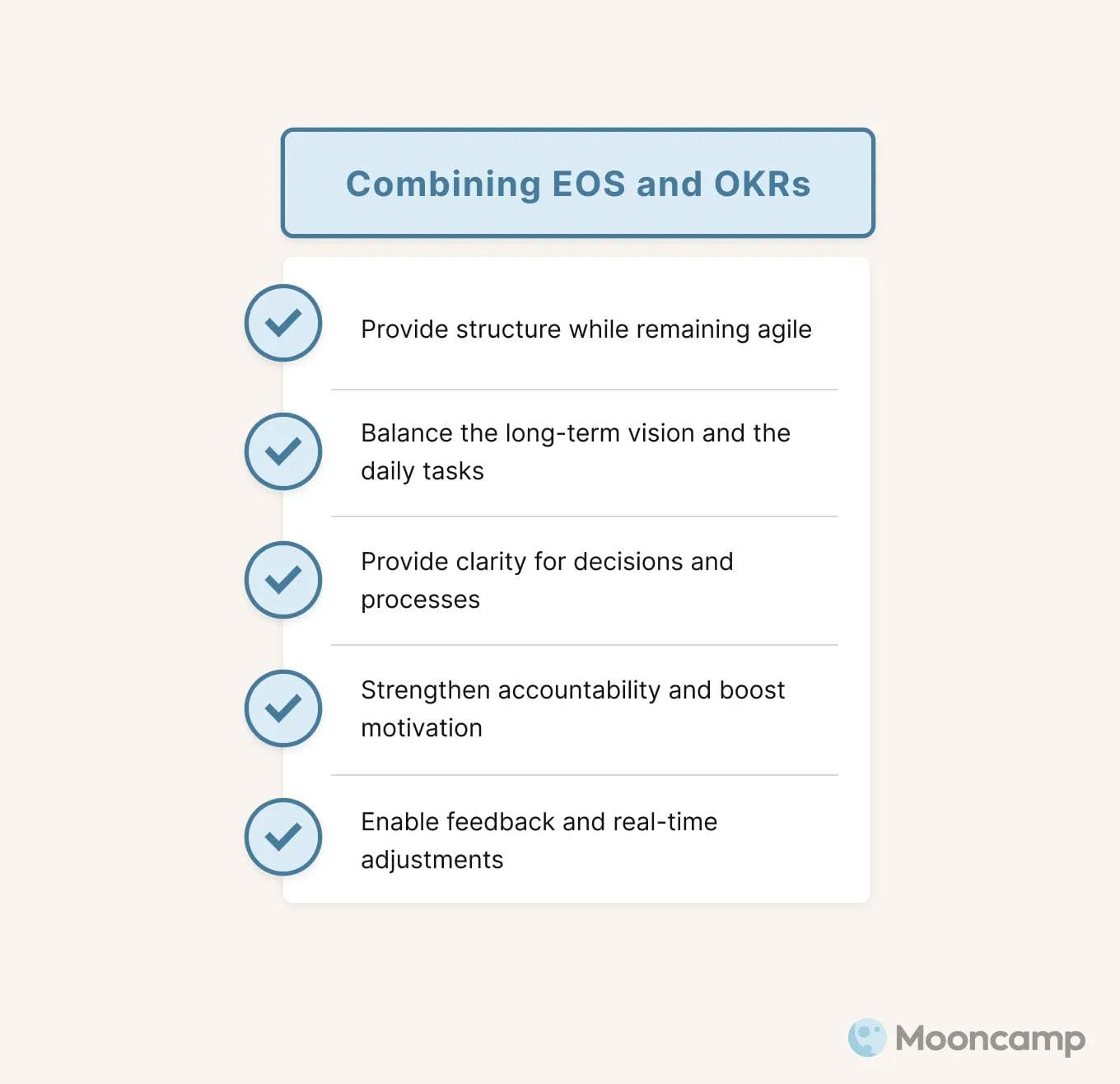
Integrating OKRs with EOS can therefore help organizations harness the best of both worlds, ensuring a clear vision, actionable goals, and consistent progress monitoring. But merging EOS with OKRs is not without its challenges. That’s why having the right tool is crucial when looking to integrate OKRs into the EOS methodology.
With a Strategy Execution & OKR software such as Mooncamp, companies of all sizes and industries can facilitate the OKR implementation process and ensure a smooth combination of the two methodologies.
Combine EOS and OKRs with Mooncamp
Mooncamp is not just an OKR software but a Strategy Execution software, that – much like the frameworks it’s built around – is completely customizable. For instance, you can rename Objectives as Rocks or customize the goal hierarchy system to fit your framework rules and needs.
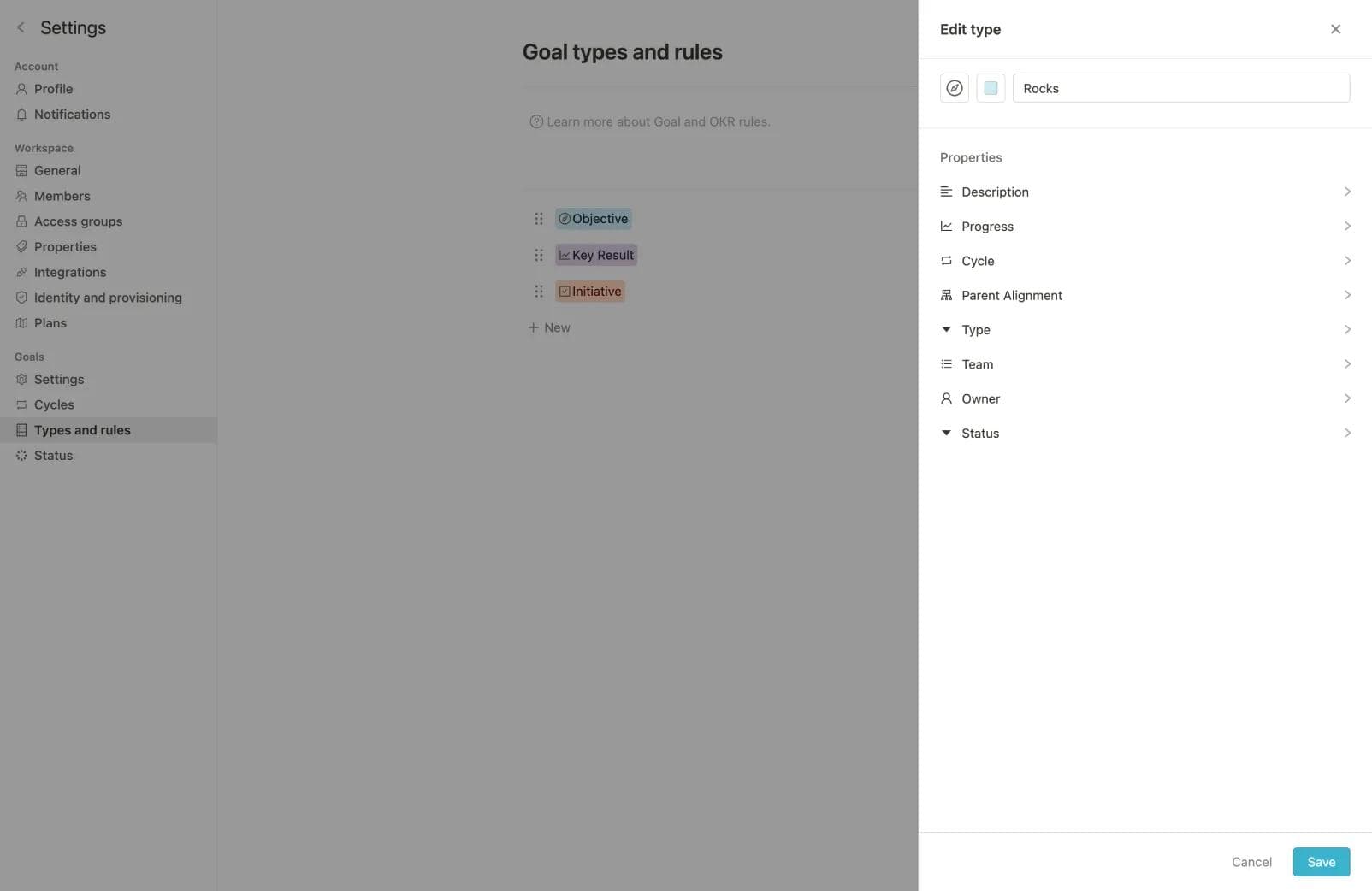
The software can also help you carry out the six components of the EOS framework. Here’s how:
Custom dashboards
With Mooncamp’s Custom Dashboards, users have maximum flexibility as they can be configured freely and can be used to visualize any kind of data for the reporting of your OKRs (or in this case Rocks) and beyond. They give you everything you need to easily integrate the six components of the EOS framework. Here are some of the features that can help you:
- Company cockpit (Vision + Data): The dashboard includes a Company Cockpit which is an executive summary encapsulating the company’s vision, mission, and values, as well as top-level KPIs and overall OKR progress. This helps set and communicate the company’s vision across all levels of the company. Additionally, the integrated scoreboard helps keep track of the KPIs and the overall progress of the Rocks.
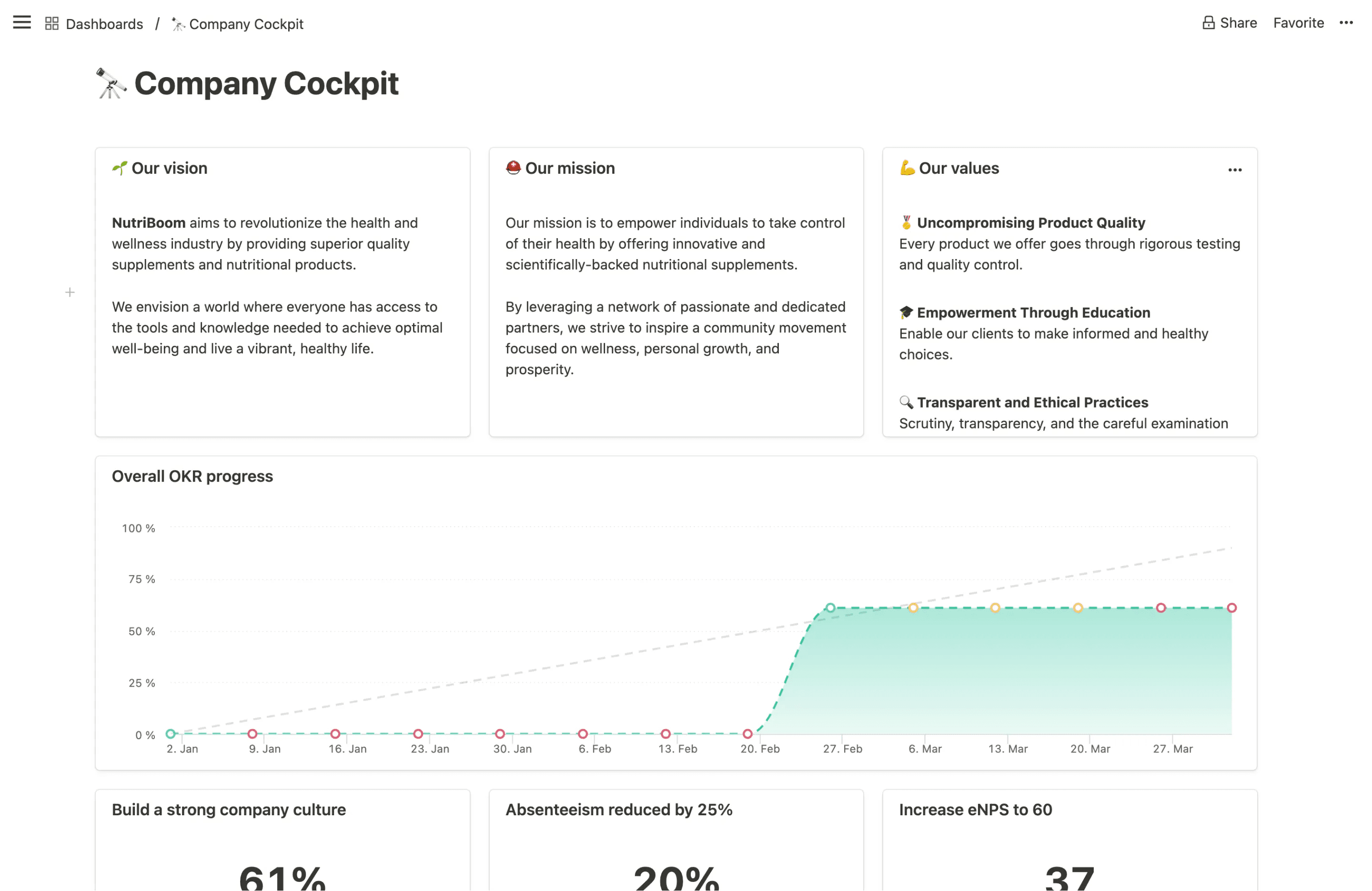
- Departmental overview (People): With the Custom Dashboards you can also create Departmental Overviews – comprehensive snapshots of a department’s mission, key metrics, goals, team members, and other possible reports, like OKR leaderboards. This ensures that the right people, in the right department, are working toward the right goal and helps teams and departments work in tandem. In the future, the dashboard will also come with a member list card, that will display the responsibilities or goals that each person is working on.
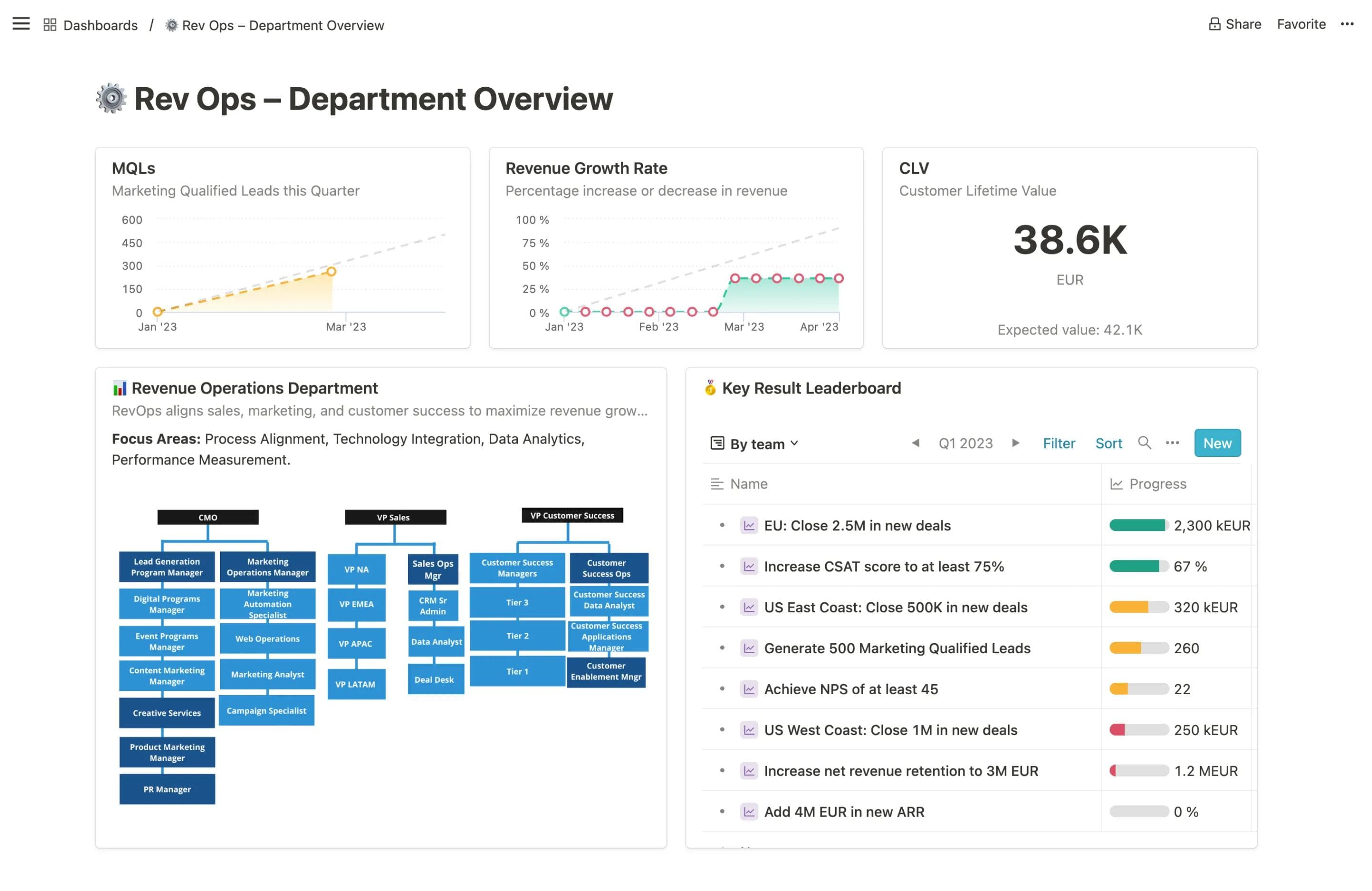
- Quarterly Business Review (Data): The Quarterly Business Review offers an in-depth analysis of quarterly achievements, growth, challenges, and strategic initiatives, as well as OKRs – or Rocks if renamed – highlights and lowlights.
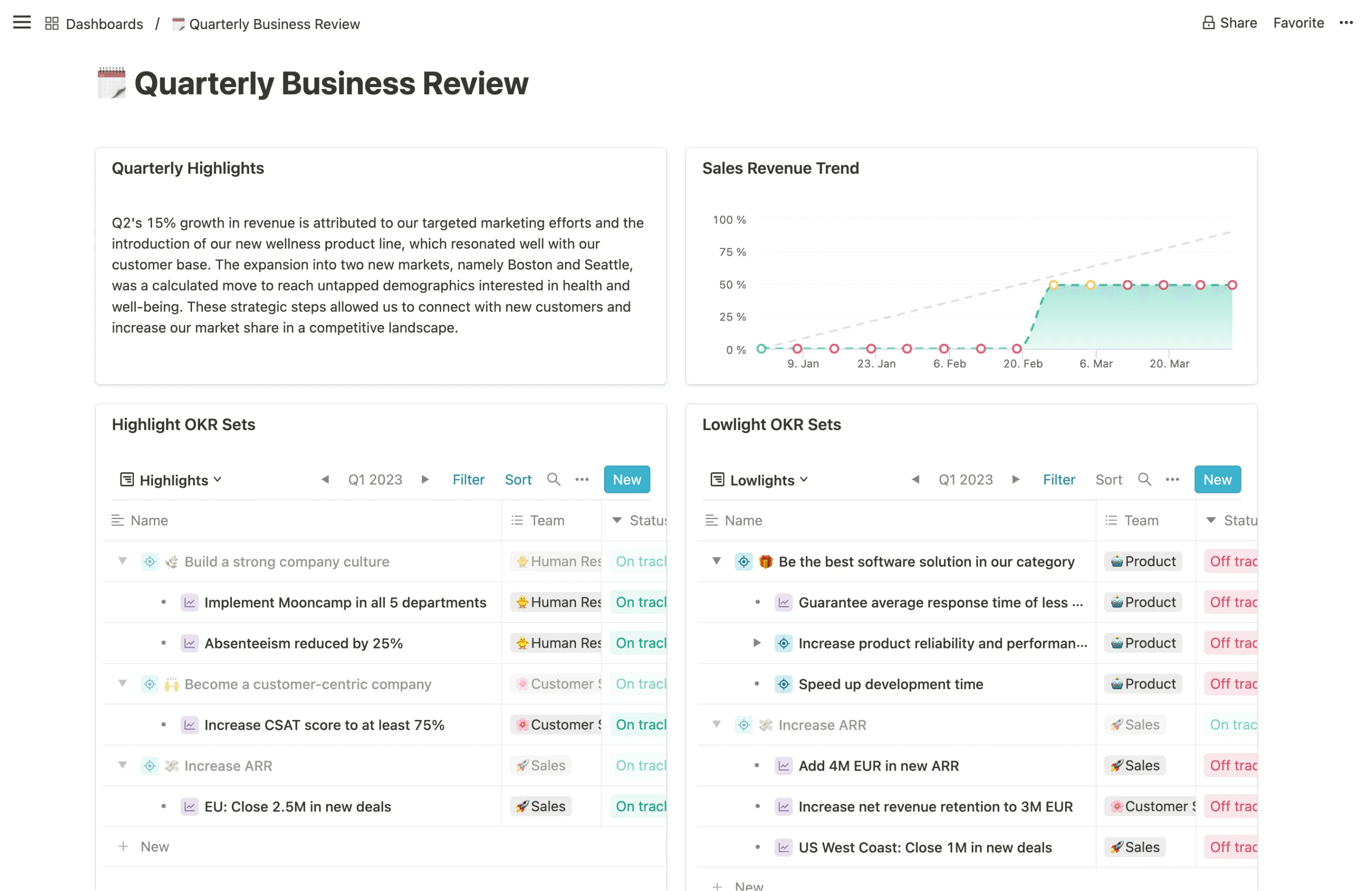
- Individualized views (Issues): Users can easily get an overview of all issues by creating a custom type “Issue” and setting up a special filter for issues on their goal list.
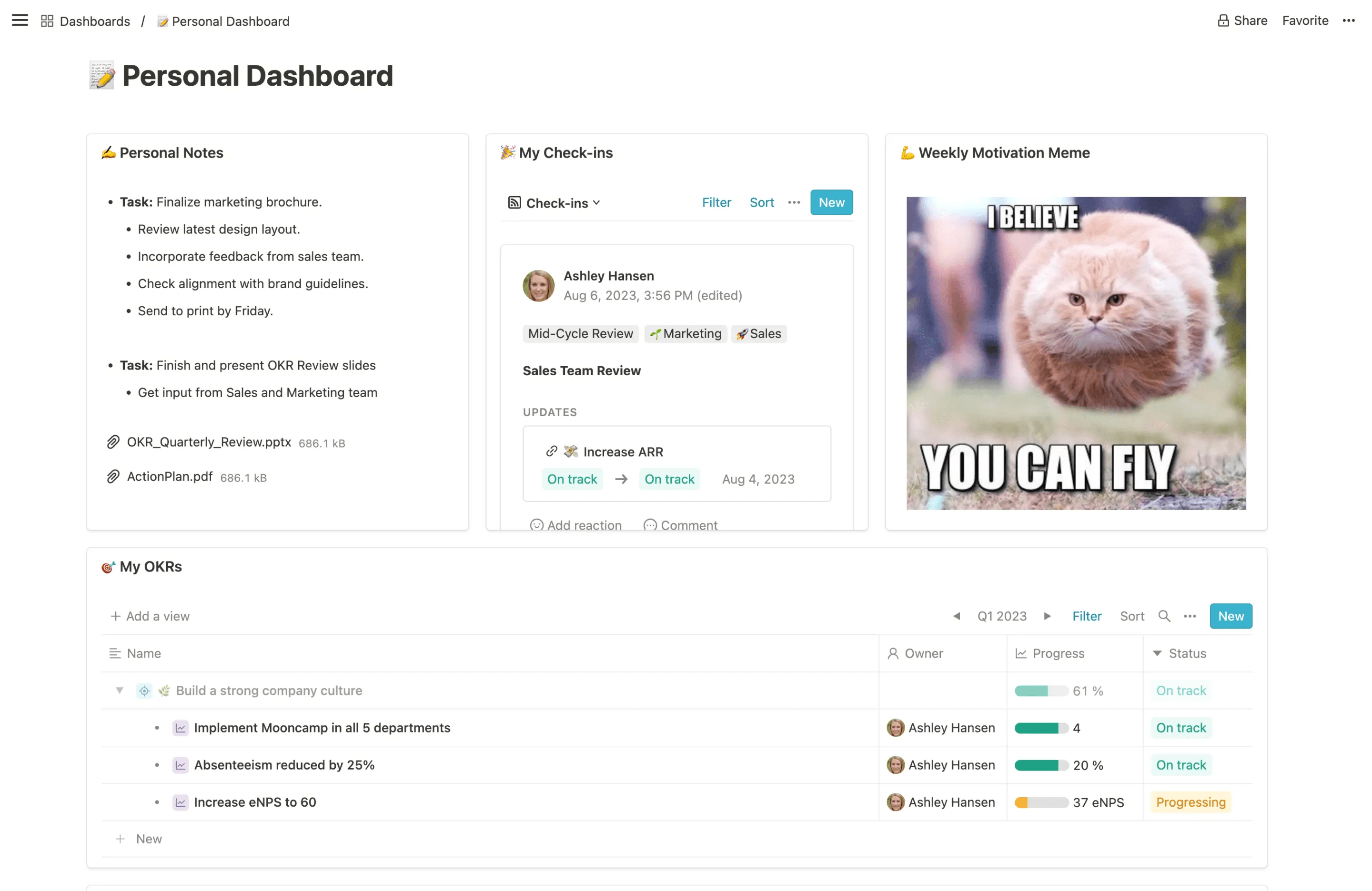
- Weekly Management Report (Process): A report that highlights key accomplishments, challenges, and focus areas for the week, aiding in short-term decision-making and planning. These reports then help create consistency in the way core business processes are executed.
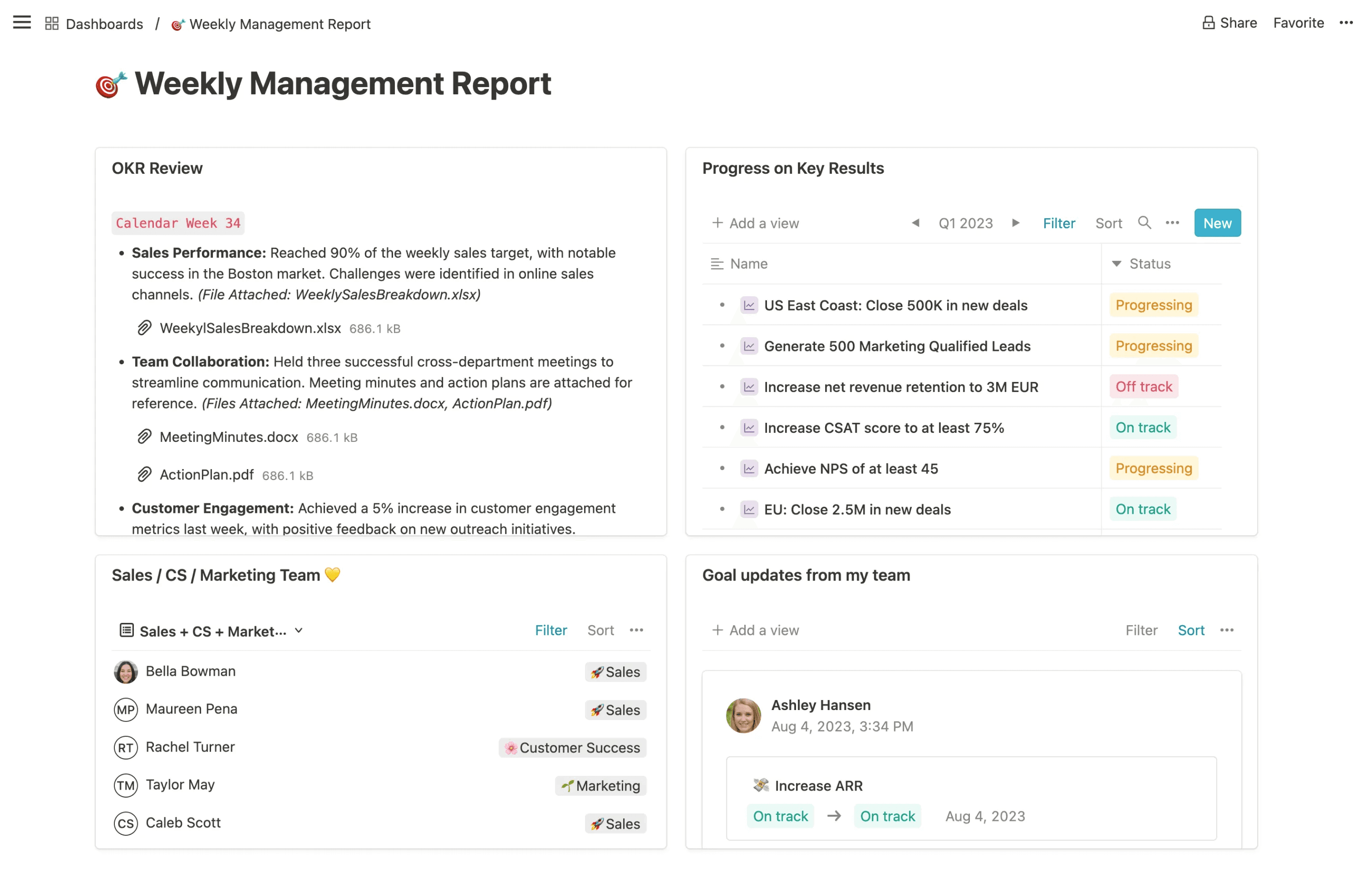
- Integrated check-ins (Process + Traction): You can use check-ins to remind everyone to update their goals and share what they are working on or what their current priorities are. This way you can replace time-consuming meetings and email threads with just a few laser-focused check-in questions, enabling the traction aspect of the EOS methodology.
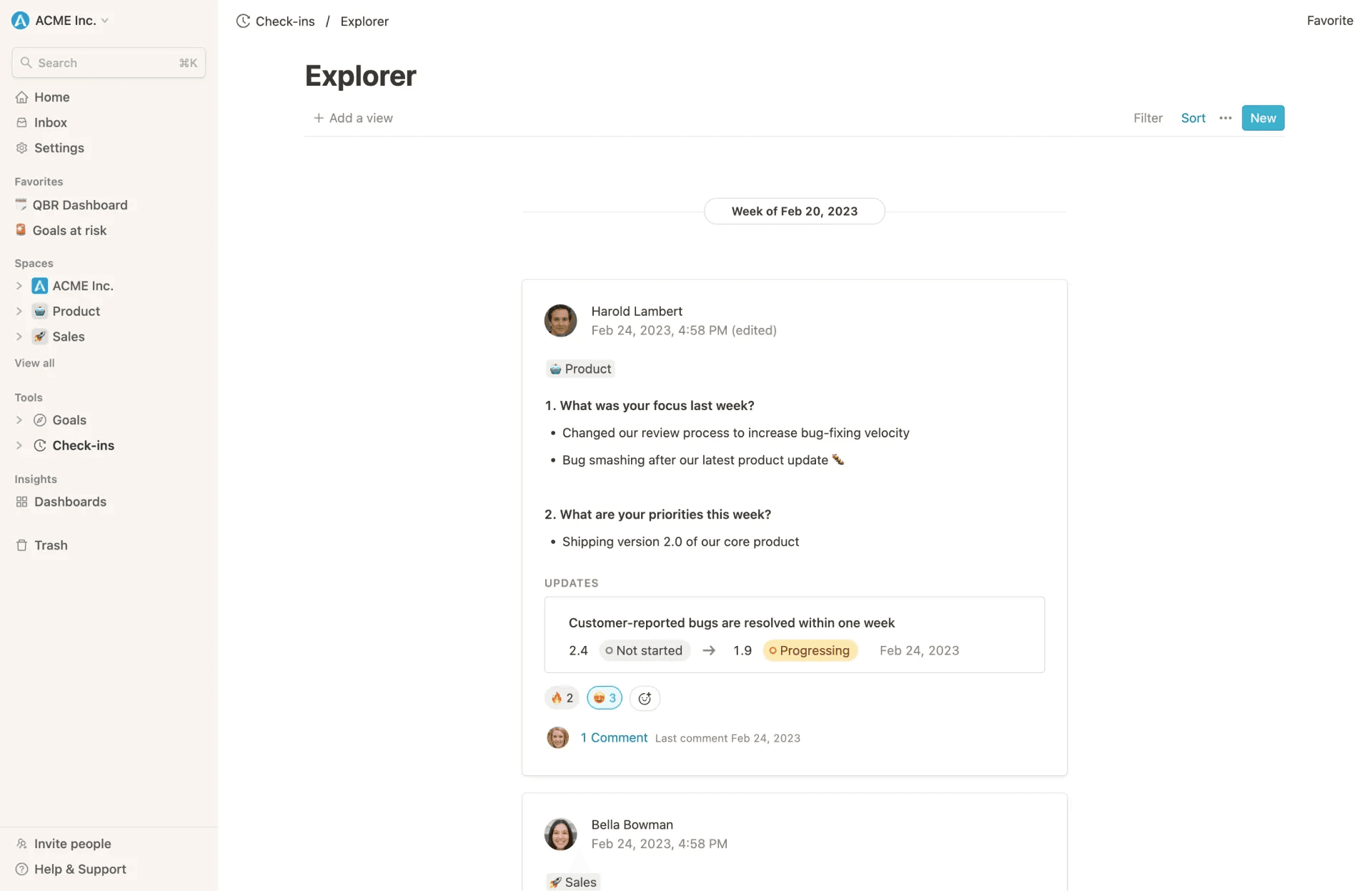
Traffic light system
The traffic light system works similarly to the EOS scorecard, as it divides the status into three different progress categories and colors them accordingly:
- Off Track – the goal deviates significantly from the plan (red)
- Progressing – the goal deviates slightly from the plan (yellow)
- On Track – the target is on track (green)
This can help teams and individuals properly score Rocks/OKRs and identify issues at a glance so that they can adjust their course of action accordingly. Think of it as an integrated EOS scorecard. The traffic light system (and goal statues) are also completely customizable.
Conclusion
To summarize: EOS gives entrepreneurial businesses a structured, straightforward path to follow towards their long-term goals by breaking them down into Rocks. It’s a solid, step-by-step guide but can get a bit too rigid for larger organizations. Conversely, OKRs offer agility, quick adjustments, and keep everyone from interns to CEOs involved and aligned. Combining the two frameworks from the get-go – EOS for structured planning and OKRs for adaptable execution – can give your company the best of both worlds while it grows.
Shape those EOS Rocks into OKR Objectives, tag on a couple of clear, trackable Key Results, and you’ve got a recipe that blends clear, big-picture strategy with adaptable, team-focused action. To simplify the whole process you can also use Strategy Execution software. That way, your whole organization can stay aligned with the big picture while also quickly adapting to inevitable bumps or opportunities that come along when one is growing as a company.

